Top Features to Look for in a Dealer Management System (DMS) in 2025

The global Dealer Management System (DMS) market is projected to reach $16.5 billion by 2030 as more dealerships shift away from paper-based processes and outdated on-premises systems. Instead, they’re adopting cloud-based, mobile-friendly solutions that streamline operations, improve efficiency, and provide real-time access to critical business data.
The best DMS solutions should do far more than just track inventory and sales. A modern system should enable you to manage your dealership from anywhere, process payments seamlessly, enhance customer interactions, and make informed business decisions using real-time insights—all from a single, centralized platform.
To help you make the best choice for your business, we’ve compiled a list of the top features to look for in a DMS in 2025. Whether you’re upgrading your current system or investing in a DMS for the first time, these must-have features will ensure your dealership stays efficient, competitive, and ready for the future.
Click to Jump Ahead:
1. One System to Run Your Entire Dealership
Before diving into specific features, it’s essential to recognize what a modern Dealer Management System (DMS) should do at its core: manage your entire dealership from a single, centralized platform. The best DMS solutions connect every department and every location under one digital roof.
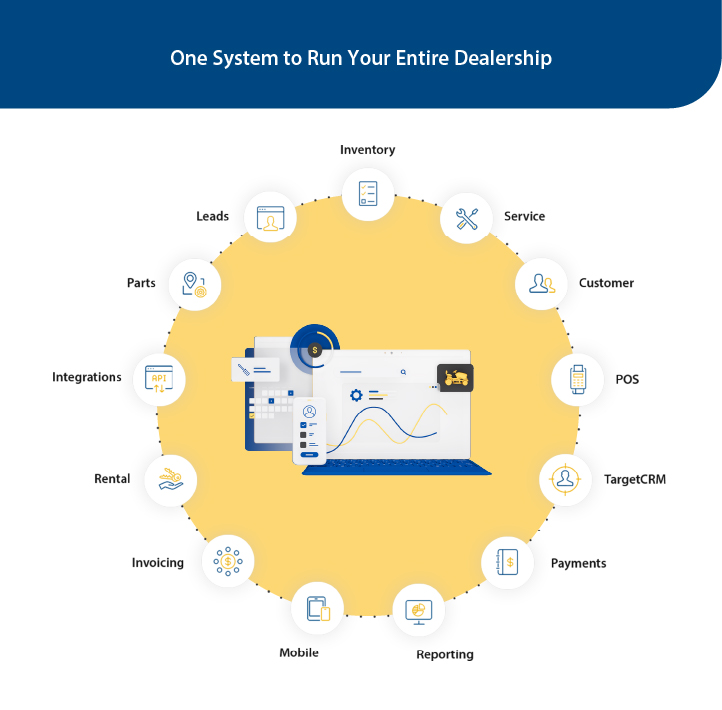
Your DMS should bring all these moving parts together, providing you with complete visibility into your operations so you can see what’s happening across your entire business in real time. Here’s what a dealership-wide DMS should offer:
Total Department & Process Integration
From front-end sales to back-end service and everything in between, your DMS should unify every department. When systems talk to each other, you eliminate data silos, reduce errors, and keep everyone on the same page.
Industry-Specific Integrations
Look for a system built for your industry, with direct integrations to suppliers, OEM systems, and third-party tools that matter most to your dealership. This saves time on manual entry and ensures you’re always working with accurate, up-to-date information.
Multi-Location Support
If your dealership has more than one location—or plans to expand—your DMS should be able to scale with you. The right system makes it easy to manage operations across locations, keeping inventory, customer data, and reporting consistent and connected.
Smooth Data Migration
Worried about switching systems? A strong DMS partner will offer data conversion services to help transfer your history from your old system without losing valuable records. That means you can make the switch with confidence, knowing your data is in good hands.
In short, your DMS should be designed to grow with your dealership and streamline operations at every level. The following five features will help you evaluate which system can truly deliver on that promise.
2. Cloud-Based Accessibility
If you’re evaluating dealership management systems (DMS) in 2025, cloud-based accessibility should be at the top of your list. On-premises dealer management systems are expensive and outdated. You’re stuck maintaining servers, troubleshooting software issues, and paying for updates—time and money that could be better spent growing your business.
Today’s leading DMS solutions operate in the cloud, giving dealerships the flexibility, scalability, and security needed to stay ahead in a competitive market.

Access Your Dealership from Anywhere, Anytime
A cloud-based dealer management system ensures that you’re not tied to a single office computer. Instead, you can log in from any device—laptop, tablet, or smartphone—and manage operations on the go.
Whether you’re on the showroom floor, in the service department, or managing multiple locations, you can view real-time inventory levels, track sales performance, and monitor service orders without being tied to a physical office.
Sync Multi-Location Operations Instantly
If your dealership has multiple locations, keeping everything in sync can be a challenge. A cloud-based DMS connects all locations in real time, ensuring that inventory, customer records, and service history stay updated across every location.
With a centralized system, you eliminate manual updates, outdated records, and duplicate data entries—making operations smoother and more efficient.
Cut IT Costs & Reduce Maintenance Hassles
One of the biggest advantages of a cloud-based DMS is the reduction in IT costs. Traditional, on-premise systems require expensive servers, regular maintenance, and costly updates—all of which add up quickly.
With a cloud-based solution, all of this is taken care of automatically. Your dealership management software provider handles:
- Software updates and security patches behind the scenes
- System maintenance to ensure uptime and performance
- Scalability, so as your dealership grows, your system grows with you—without expensive overhauls.
This reduces overall IT expenses and allows dealerships to allocate resources to more critical areas, such as customer service, marketing, and inventory management.
Read Next: Choosing Your Dealership Management System: A Complete Guide
3. Mobile & On-the-Go Management
Modern buyers don’t want to wait for answers. Whether they’re shopping for new equipment or checking on a repair, they expect immediate service and clear communication. Mobile access allows your team to respond instantly—without delays or callbacks.
A mobile-friendly DMS gives your team instant access to customer data, inventory, work orders, and invoicing—all from their smartphones or tablets. No more running back to a desktop computer, no more delays in updating records. Every interaction, every sale, and every service job can be managed in real time, no matter where you are.
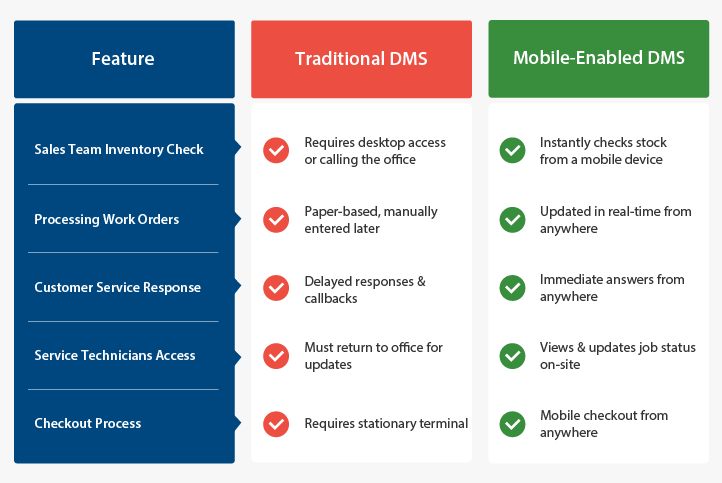
Instant Access to Customer & Inventory Data
Your sales team shouldn’t have to step away from a customer just to check if an item is in stock. A mobile-enabled DMS lets them view inventory levels instantly, confirm pricing, and even process sales on the spot—without leaving the customer’s side.
For field sales reps and service technicians, this access is crucial. Instead of calling back to the dealership for updates or waiting to enter information manually, they can retrieve real-time customer history, previous service records, and part availability with just a few taps. This eliminates delays, improves accuracy, and creates a smoother experience for both employees and customers.
By giving your service team the tools they need to access, update, and manage work orders from the field, you reduce downtime, increase efficiency, and ensure customers get the service they expect—without the frustrating back-and-forth.
4. Built-in Payment Processing for A Seamless Checkout Experience
One of the most overlooked but critical features in a dealer management system (DMS) is integrated payment processing. Many dealerships still rely on third-party payment processors, leading to manual reconciliation, increased fees, and inefficiencies at checkout.
A DMS with built-in payment processing, like integrated payments from Ideal Computer Systems, eliminates the need for external payment providers, ensuring a frictionless checkout experience for both your team and your customers. Instead of toggling between multiple systems to process payments, reconcile transactions, and update financial records, an integrated solution keeps everything in one place.
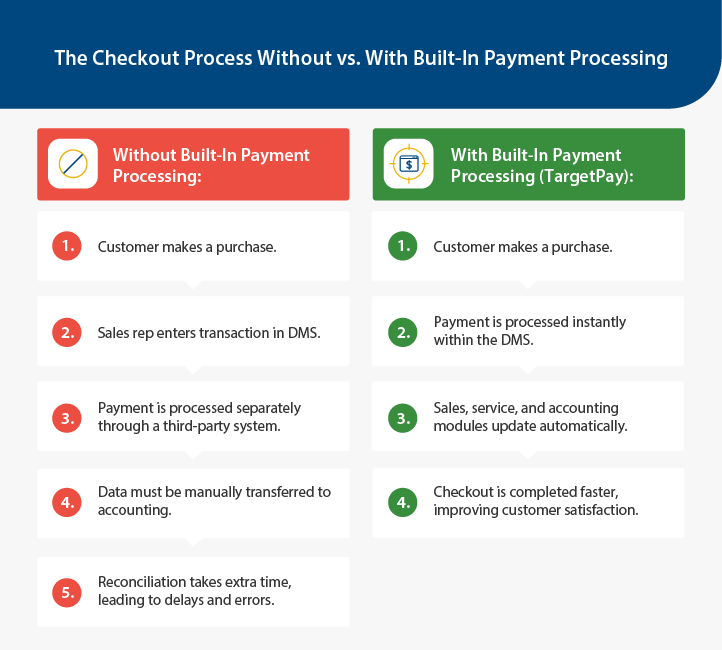
With an integrated payment processing system, you get:
- Faster Transactions: Reduce checkout times in both the showroom and service department, leading to improved customer satisfaction.
- Automated Reconciliation: Payments sync automatically with sales, service, and accounting modules, eliminating manual entry.
- Improved Security & Compliance: With end-to-end encryption and PCI compliance, customer data is protected at every step.
As dealerships continue to digitize their operations, having an integrated payment processing system reduces inefficiencies, improves cash flow visibility, and enhances customer convenience.
5. Advanced CRM & Customer Experience Management
Dealerships rely on long-term customer relationships—whether it’s selling a new mower, servicing existing equipment, or providing seasonal maintenance. Without a CRM built into your DMS, it’s easy for leads to fall through the cracks, follow-ups to be forgotten, and customers to turn to competitors.
A fully integrated CRM ensures that every customer interaction, sales opportunity, and service request is tracked and optimized for better retention and increased revenue.
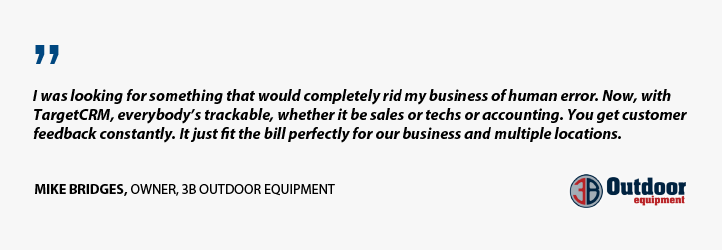
When evaluating CRM capabilities in a DMS, here’s what you should look for:
- Tracks customer interactions & purchase history – Keep detailed records of past purchases, service history, and preferences for better customer engagement.
- Automates marketing campaigns & follow-ups – Schedule personalized emails and texts based on customer activity.
- Website lead capture & sales funnel tracking – Automatically pull online leads into the CRM and monitor their journey through the sales pipeline.
- Identifies sales bottlenecks & rep performance – See where leads drop off and compare sales rep activity to coach underperformers.
- Integrated texting & email for real-time communication – Eliminate third-party tools and send messages directly from the CRM.
- Automated NPS & customer satisfaction tracking – Measure customer feedback post-sale to improve retention.
Your ability to track, engage, and retain customers is just as important as selling equipment. If you’re still using spreadsheets or outdated CRM tools, you’re missing out on critical insights and automation that can help drive revenue and repeat business.
Read Next: How TargetCRM Transformed Customer Engagement for These 5 Dealerships
6. Customizable Dashboards & Data Analytics for Performance Tracking
Every day, dealerships generate vast amounts of data—sales transactions, inventory movement, service orders, and customer interactions. However, many dealers struggle to effectively harness this information, leading to gut-based decisions rather than data-driven strategies. Without clear insights into key performance metrics, dealerships risk inefficiencies, lost sales, and missed opportunities for growth.
A modern dealer management system should act as a built-in business intelligence tool, offering real-time insights into every department. That’s why one of the most important features to look for in 2025 should be powerful analytics and customizable dashboards.
For example:
- Inventory turnover reports reveal which equipment models are selling quickly and which are stagnating, helping dealers adjust stock levels, pricing, or promotions.
- Service department analytics can pinpoint underperforming areas, allowing managers to fine-tune staffing, labor rates, and service packages for maximum efficiency.
- Sales performance tracking helps identify top-performing team members and those who may need additional training or support.
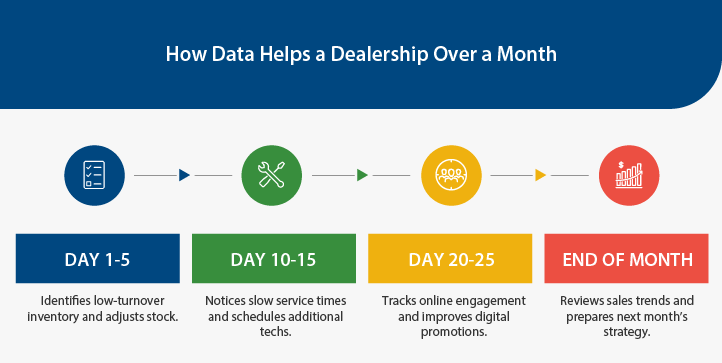
One often-overlooked area of dealership data is online sales and digital engagement. Many dealers focus primarily on in-store performance metrics, neglecting the fact that their website plays a critical role in driving revenue. But your online presence is just as important as your showroom.
TargetWeb is a dealer-branded website solution that integrates seamlessly with Ideal’s DMS, ensuring that all online inquiries, promotions, and sales data are automatically included in your dealership reports. This means you can:
- Track which products are getting the most online views and conversions
- Measure how digital leads compare to in-store walk-ins
- Ensure online service appointment bookings are properly managed
- Align website promotions with in-store sales strategies
By integrating website analytics with dealership performance tracking, you get a 360-degree view of your entire business—both online and offline. In 2025, dealerships that leverage real-time data will outperform competitors who are still relying on manual reports and guesswork.
Future-Proof Your Dealership with the Right DMS
If you’re still relying on outdated systems, disconnected tools, or manual processes, it’s time to ask yourself: is your current DMS helping your dealership grow, or is it holding you back?
If your current DMS isn’t keeping up with the way you do business today, it certainly won’t help you thrive in 2025 and beyond. Whether it’s accessing real-time data from anywhere, processing transactions faster, or tracking customer engagement, the best DMS solutions work for you—not the other way around.
The future of your dealership starts now, and with the right DMS, the possibilities are endless.


